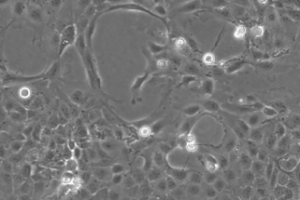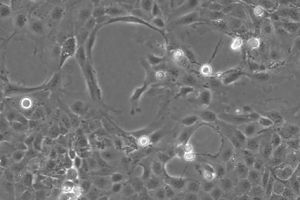Cell Line Profile PNT2
(ECACC catalogue no. 95012613)
Cell line history
The human cell line PNT2 originated from the normal prostate tissue of a deceased 33 year old male. A plasmid containing a Simian virus genome with a defective replication origin (SV40 ori-) was used to immortalise the cell line. The Simian virus is commonly used to immortalise mammalian epithelial cells (Cussenot et al, 1991). In the case of PNT1A and PNT2, the large T protein was used as the immortalising agent and liposomes were used as vectors (Cussenot et al, 1991). The use of SV40-immortalised cell lines instead of hTERT-immortalised cell lines is regarded to be more appropriate for research into carcinogenesis (Toouli et al, 2002).


48 hours post resuscitation Prior to cryopreservation
Key characteristics
PNT2 cells are attached cell lines which grow with an epithelial morphology. PNT2 expresses cytokeratin (CK) 8, 18, and 19, members of the keratin family. The keratin family are responsible for maintaining the structure of epithelial cells. CK8 and CK18 are assembled together as partners, and function as plasminogen receptors (Gonias et al, 2001). CK19 is expressed in the periderm (RefSeq, 2008), and is a feature of differentiated luminal cells.
Applications
PNT2 cells are commonly used in cancer research, for instance by Baker et al in 2008, which used secondary ion mass spectrometry to distinguish between prostate cancer cells and non-malignant cells. They have also been used by Faria et al in 2008 as part of an investigation into the measurement of the elastic properties of prostate cancer using Atomic Force Microscopy (AFM). Another example of PNT2’s application is by Smith et al in 1998, where sodium channel expression was shown to enhance the invasiveness of human and rat prostate cancer cells.
Culture tips
The media that PNT2 should be cultured in is RPMI 1640 + 2mM Glutamine + 6-10% Foetal Bovine Serum (FBS) at 37°C + 5% CO2. The cells should be seeded at around 2-4 x 104 cells/cm2 and should be passaged when the subculture is between 70-80% confluent using 0.25% trypsin or trypsin/EDTA. These cells should be handled under laboratory containment level 2.
|
Related cell lines |
ECACC catalogue number |
Description |
|---|---|---|
|
PNT2 (Serum free) |
A derivative of PNT2 adapted to grow in serum free media. |
|
|
PNT1A |
35 year old male human prostate epithelial cells immortalised by SV40 ori-, presenting the phenotype of differentiated luminal prostatic cells with the expression of cytokeratin 8 and 18, and vimentin. Cytokeratin 14 is not expressed. These cells are non-tumourigenic in mice |
|
|
PNT1A (Serum free) |
A derivative of PNT1A adapted to grow in serum free media. |
Key references
-
Cussenot, O., et al., Immortalization of Human Adult Normal Prostatic Epithelial Cells by Liposomes Containing Large T-SV40 Gene. The Journal of Urology, 1991. 146(3): p. 881-886.
-
Toouli, C.D., et al., Comparison of human mammary epithelial cells immortalized by simian virus 40 T-Antigen or by the telomerase catalytic subunit. Oncogene, 2002. 21: p. 128.
-
Gonias, S.L., T.A. Hembrough, and M. Sankovic, Cytokeratin 8 functions as a major plasminogen receptor in select epithelial and carcinoma cells. Front Biosci, 2001. 6: p. D1403-11.
-
RefSeq. KRT19 Keratin 19 (human). 2008 8 Apr 2018; Available from: https://www.ncbi.nlm.nih.gov/gene/3880.
-
Baker, M.J., et al., Discrimination of prostate cancer cells and non-malignant cells using secondary ion mass spectrometry. Analyst, 2008. 133(2): p. 175-179.
-
Faria, E.C., et al., Measurement of elastic properties of prostate cancer cells using AFM. Analyst, 2008. 133(11): p. 1498-1500.
-
Smith, P., et al., Sodium channel protein expression enhances the invasiveness of rat and human prostate cancer cells. FEBS Letters, 1998. 423(1): p. 19-24.
